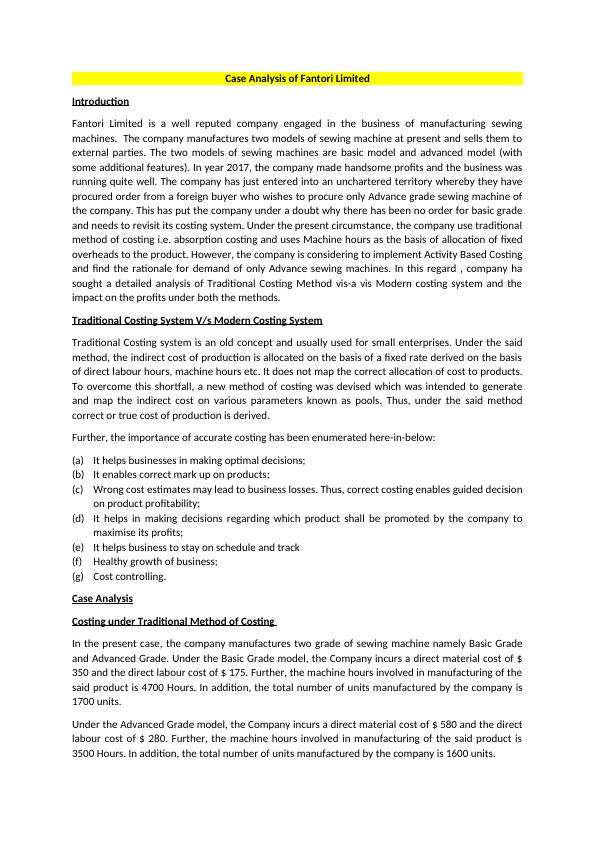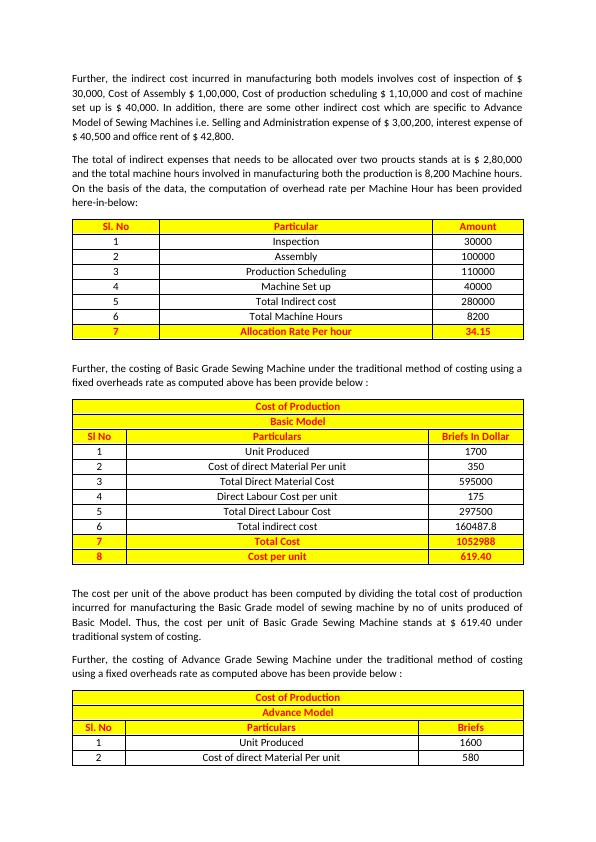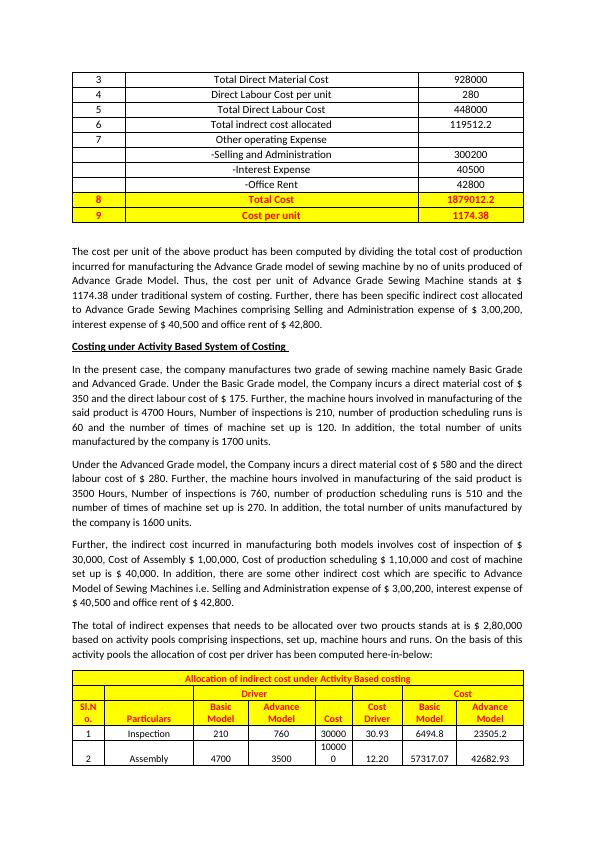Case Analysis of Fantori Limited
6 Pages2518 Words285 Views
Added on 2023-04-23
About This Document
This case analysis compares traditional and modern costing systems for Fantori Limited, a sewing machine manufacturer. It includes a detailed breakdown of costs and profitability under both methods.
Case Analysis of Fantori Limited
Added on 2023-04-23
ShareRelated Documents
Case Analysis of Fantori Limited
Introduction
Fantori Limited is a well reputed company engaged in the business of manufacturing sewing
machines. The company manufactures two models of sewing machine at present and sells them to
external parties. The two models of sewing machines are basic model and advanced model (with
some additional features). In year 2017, the company made handsome profits and the business was
running quite well. The company has just entered into an unchartered territory whereby they have
procured order from a foreign buyer who wishes to procure only Advance grade sewing machine of
the company. This has put the company under a doubt why there has been no order for basic grade
and needs to revisit its costing system. Under the present circumstance, the company use traditional
method of costing i.e. absorption costing and uses Machine hours as the basis of allocation of fixed
overheads to the product. However, the company is considering to implement Activity Based Costing
and find the rationale for demand of only Advance sewing machines. In this regard , company ha
sought a detailed analysis of Traditional Costing Method vis-a vis Modern costing system and the
impact on the profits under both the methods.
Traditional Costing System V/s Modern Costing System
Traditional Costing system is an old concept and usually used for small enterprises. Under the said
method, the indirect cost of production is allocated on the basis of a fixed rate derived on the basis
of direct labour hours, machine hours etc. It does not map the correct allocation of cost to products.
To overcome this shortfall, a new method of costing was devised which was intended to generate
and map the indirect cost on various parameters known as pools. Thus, under the said method
correct or true cost of production is derived.
Further, the importance of accurate costing has been enumerated here-in-below:
(a) It helps businesses in making optimal decisions;
(b) It enables correct mark up on products;
(c) Wrong cost estimates may lead to business losses. Thus, correct costing enables guided decision
on product profitability;
(d) It helps in making decisions regarding which product shall be promoted by the company to
maximise its profits;
(e) It helps business to stay on schedule and track
(f) Healthy growth of business;
(g) Cost controlling.
Case Analysis
Costing under Traditional Method of Costing
In the present case, the company manufactures two grade of sewing machine namely Basic Grade
and Advanced Grade. Under the Basic Grade model, the Company incurs a direct material cost of $
350 and the direct labour cost of $ 175. Further, the machine hours involved in manufacturing of the
said product is 4700 Hours. In addition, the total number of units manufactured by the company is
1700 units.
Under the Advanced Grade model, the Company incurs a direct material cost of $ 580 and the direct
labour cost of $ 280. Further, the machine hours involved in manufacturing of the said product is
3500 Hours. In addition, the total number of units manufactured by the company is 1600 units.
Introduction
Fantori Limited is a well reputed company engaged in the business of manufacturing sewing
machines. The company manufactures two models of sewing machine at present and sells them to
external parties. The two models of sewing machines are basic model and advanced model (with
some additional features). In year 2017, the company made handsome profits and the business was
running quite well. The company has just entered into an unchartered territory whereby they have
procured order from a foreign buyer who wishes to procure only Advance grade sewing machine of
the company. This has put the company under a doubt why there has been no order for basic grade
and needs to revisit its costing system. Under the present circumstance, the company use traditional
method of costing i.e. absorption costing and uses Machine hours as the basis of allocation of fixed
overheads to the product. However, the company is considering to implement Activity Based Costing
and find the rationale for demand of only Advance sewing machines. In this regard , company ha
sought a detailed analysis of Traditional Costing Method vis-a vis Modern costing system and the
impact on the profits under both the methods.
Traditional Costing System V/s Modern Costing System
Traditional Costing system is an old concept and usually used for small enterprises. Under the said
method, the indirect cost of production is allocated on the basis of a fixed rate derived on the basis
of direct labour hours, machine hours etc. It does not map the correct allocation of cost to products.
To overcome this shortfall, a new method of costing was devised which was intended to generate
and map the indirect cost on various parameters known as pools. Thus, under the said method
correct or true cost of production is derived.
Further, the importance of accurate costing has been enumerated here-in-below:
(a) It helps businesses in making optimal decisions;
(b) It enables correct mark up on products;
(c) Wrong cost estimates may lead to business losses. Thus, correct costing enables guided decision
on product profitability;
(d) It helps in making decisions regarding which product shall be promoted by the company to
maximise its profits;
(e) It helps business to stay on schedule and track
(f) Healthy growth of business;
(g) Cost controlling.
Case Analysis
Costing under Traditional Method of Costing
In the present case, the company manufactures two grade of sewing machine namely Basic Grade
and Advanced Grade. Under the Basic Grade model, the Company incurs a direct material cost of $
350 and the direct labour cost of $ 175. Further, the machine hours involved in manufacturing of the
said product is 4700 Hours. In addition, the total number of units manufactured by the company is
1700 units.
Under the Advanced Grade model, the Company incurs a direct material cost of $ 580 and the direct
labour cost of $ 280. Further, the machine hours involved in manufacturing of the said product is
3500 Hours. In addition, the total number of units manufactured by the company is 1600 units.

Further, the indirect cost incurred in manufacturing both models involves cost of inspection of $
30,000, Cost of Assembly $ 1,00,000, Cost of production scheduling $ 1,10,000 and cost of machine
set up is $ 40,000. In addition, there are some other indirect cost which are specific to Advance
Model of Sewing Machines i.e. Selling and Administration expense of $ 3,00,200, interest expense of
$ 40,500 and office rent of $ 42,800.
The total of indirect expenses that needs to be allocated over two proucts stands at is $ 2,80,000
and the total machine hours involved in manufacturing both the production is 8,200 Machine hours.
On the basis of the data, the computation of overhead rate per Machine Hour has been provided
here-in-below:
Sl. No Particular Amount
1 Inspection 30000
2 Assembly 100000
3 Production Scheduling 110000
4 Machine Set up 40000
5 Total Indirect cost 280000
6 Total Machine Hours 8200
7 Allocation Rate Per hour 34.15
Further, the costing of Basic Grade Sewing Machine under the traditional method of costing using a
fixed overheads rate as computed above has been provide below :
Cost of Production
Basic Model
Sl No Particulars Briefs In Dollar
1 Unit Produced 1700
2 Cost of direct Material Per unit 350
3 Total Direct Material Cost 595000
4 Direct Labour Cost per unit 175
5 Total Direct Labour Cost 297500
6 Total indirect cost 160487.8
7 Total Cost 1052988
8 Cost per unit 619.40
The cost per unit of the above product has been computed by dividing the total cost of production
incurred for manufacturing the Basic Grade model of sewing machine by no of units produced of
Basic Model. Thus, the cost per unit of Basic Grade Sewing Machine stands at $ 619.40 under
traditional system of costing.
Further, the costing of Advance Grade Sewing Machine under the traditional method of costing
using a fixed overheads rate as computed above has been provide below :
Cost of Production
Advance Model
Sl. No Particulars Briefs
1 Unit Produced 1600
2 Cost of direct Material Per unit 580
30,000, Cost of Assembly $ 1,00,000, Cost of production scheduling $ 1,10,000 and cost of machine
set up is $ 40,000. In addition, there are some other indirect cost which are specific to Advance
Model of Sewing Machines i.e. Selling and Administration expense of $ 3,00,200, interest expense of
$ 40,500 and office rent of $ 42,800.
The total of indirect expenses that needs to be allocated over two proucts stands at is $ 2,80,000
and the total machine hours involved in manufacturing both the production is 8,200 Machine hours.
On the basis of the data, the computation of overhead rate per Machine Hour has been provided
here-in-below:
Sl. No Particular Amount
1 Inspection 30000
2 Assembly 100000
3 Production Scheduling 110000
4 Machine Set up 40000
5 Total Indirect cost 280000
6 Total Machine Hours 8200
7 Allocation Rate Per hour 34.15
Further, the costing of Basic Grade Sewing Machine under the traditional method of costing using a
fixed overheads rate as computed above has been provide below :
Cost of Production
Basic Model
Sl No Particulars Briefs In Dollar
1 Unit Produced 1700
2 Cost of direct Material Per unit 350
3 Total Direct Material Cost 595000
4 Direct Labour Cost per unit 175
5 Total Direct Labour Cost 297500
6 Total indirect cost 160487.8
7 Total Cost 1052988
8 Cost per unit 619.40
The cost per unit of the above product has been computed by dividing the total cost of production
incurred for manufacturing the Basic Grade model of sewing machine by no of units produced of
Basic Model. Thus, the cost per unit of Basic Grade Sewing Machine stands at $ 619.40 under
traditional system of costing.
Further, the costing of Advance Grade Sewing Machine under the traditional method of costing
using a fixed overheads rate as computed above has been provide below :
Cost of Production
Advance Model
Sl. No Particulars Briefs
1 Unit Produced 1600
2 Cost of direct Material Per unit 580

3 Total Direct Material Cost 928000
4 Direct Labour Cost per unit 280
5 Total Direct Labour Cost 448000
6 Total indrect cost allocated 119512.2
7 Other operating Expense
-Selling and Administration 300200
-Interest Expense 40500
-Office Rent 42800
8 Total Cost 1879012.2
9 Cost per unit 1174.38
The cost per unit of the above product has been computed by dividing the total cost of production
incurred for manufacturing the Advance Grade model of sewing machine by no of units produced of
Advance Grade Model. Thus, the cost per unit of Advance Grade Sewing Machine stands at $
1174.38 under traditional system of costing. Further, there has been specific indirect cost allocated
to Advance Grade Sewing Machines comprising Selling and Administration expense of $ 3,00,200,
interest expense of $ 40,500 and office rent of $ 42,800.
Costing under Activity Based System of Costing
In the present case, the company manufactures two grade of sewing machine namely Basic Grade
and Advanced Grade. Under the Basic Grade model, the Company incurs a direct material cost of $
350 and the direct labour cost of $ 175. Further, the machine hours involved in manufacturing of the
said product is 4700 Hours, Number of inspections is 210, number of production scheduling runs is
60 and the number of times of machine set up is 120. In addition, the total number of units
manufactured by the company is 1700 units.
Under the Advanced Grade model, the Company incurs a direct material cost of $ 580 and the direct
labour cost of $ 280. Further, the machine hours involved in manufacturing of the said product is
3500 Hours, Number of inspections is 760, number of production scheduling runs is 510 and the
number of times of machine set up is 270. In addition, the total number of units manufactured by
the company is 1600 units.
Further, the indirect cost incurred in manufacturing both models involves cost of inspection of $
30,000, Cost of Assembly $ 1,00,000, Cost of production scheduling $ 1,10,000 and cost of machine
set up is $ 40,000. In addition, there are some other indirect cost which are specific to Advance
Model of Sewing Machines i.e. Selling and Administration expense of $ 3,00,200, interest expense of
$ 40,500 and office rent of $ 42,800.
The total of indirect expenses that needs to be allocated over two proucts stands at is $ 2,80,000
based on activity pools comprising inspections, set up, machine hours and runs. On the basis of this
activity pools the allocation of cost per driver has been computed here-in-below:
Allocation of indirect cost under Activity Based costing
Driver Cost
Sl.N
o. Particulars
Basic
Model
Advance
Model Cost
Cost
Driver
Basic
Model
Advance
Model
1 Inspection 210 760 30000 30.93 6494.8 23505.2
2 Assembly 4700 3500
10000
0 12.20 57317.07 42682.93
4 Direct Labour Cost per unit 280
5 Total Direct Labour Cost 448000
6 Total indrect cost allocated 119512.2
7 Other operating Expense
-Selling and Administration 300200
-Interest Expense 40500
-Office Rent 42800
8 Total Cost 1879012.2
9 Cost per unit 1174.38
The cost per unit of the above product has been computed by dividing the total cost of production
incurred for manufacturing the Advance Grade model of sewing machine by no of units produced of
Advance Grade Model. Thus, the cost per unit of Advance Grade Sewing Machine stands at $
1174.38 under traditional system of costing. Further, there has been specific indirect cost allocated
to Advance Grade Sewing Machines comprising Selling and Administration expense of $ 3,00,200,
interest expense of $ 40,500 and office rent of $ 42,800.
Costing under Activity Based System of Costing
In the present case, the company manufactures two grade of sewing machine namely Basic Grade
and Advanced Grade. Under the Basic Grade model, the Company incurs a direct material cost of $
350 and the direct labour cost of $ 175. Further, the machine hours involved in manufacturing of the
said product is 4700 Hours, Number of inspections is 210, number of production scheduling runs is
60 and the number of times of machine set up is 120. In addition, the total number of units
manufactured by the company is 1700 units.
Under the Advanced Grade model, the Company incurs a direct material cost of $ 580 and the direct
labour cost of $ 280. Further, the machine hours involved in manufacturing of the said product is
3500 Hours, Number of inspections is 760, number of production scheduling runs is 510 and the
number of times of machine set up is 270. In addition, the total number of units manufactured by
the company is 1600 units.
Further, the indirect cost incurred in manufacturing both models involves cost of inspection of $
30,000, Cost of Assembly $ 1,00,000, Cost of production scheduling $ 1,10,000 and cost of machine
set up is $ 40,000. In addition, there are some other indirect cost which are specific to Advance
Model of Sewing Machines i.e. Selling and Administration expense of $ 3,00,200, interest expense of
$ 40,500 and office rent of $ 42,800.
The total of indirect expenses that needs to be allocated over two proucts stands at is $ 2,80,000
based on activity pools comprising inspections, set up, machine hours and runs. On the basis of this
activity pools the allocation of cost per driver has been computed here-in-below:
Allocation of indirect cost under Activity Based costing
Driver Cost
Sl.N
o. Particulars
Basic
Model
Advance
Model Cost
Cost
Driver
Basic
Model
Advance
Model
1 Inspection 210 760 30000 30.93 6494.8 23505.2
2 Assembly 4700 3500
10000
0 12.20 57317.07 42682.93

End of preview
Want to access all the pages? Upload your documents or become a member.
Related Documents
Business Accounting Assignment : Sewing Easy Ltdlg...
|15
|3157
|29
Costing of Sewing Machine Models using Traditional and Activity Based Costinglg...
|12
|2572
|72
Calculation of cost per unit of sewing machines under the current costing system: Sewing Easy Ltd Particulars Basic Model Advance Model Amount Amount Direct material costslg...
|9
|1031
|453
Project Description: Costing of Productslg...
|12
|2712
|463
Traditional and ABC Costing - PDFlg...
|14
|2470
|95
Management Accounting Assignment Term 1 2018lg...
|9
|2261
|235
